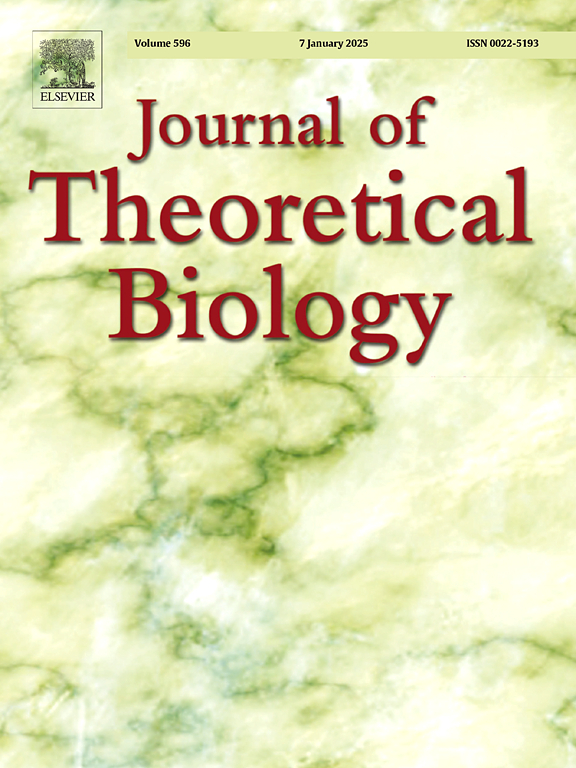The consequence of uneven walking transitory modulation strategies: A simulation-based approach
IF 2
4区 数学
Q2 BIOLOGY
引用次数: 0
Abstract
Human gait control involves regulating multiple parameters, particularly when navigating uneven terrain. Terrain perturbations can introduce substantial challenges. While the regulation of total step mechanical work across multiple steps has been studied, other observed measures of gait adjustment remain less explored. Using an analytical model, we examined the center of mass (COM) mechanical work and step frequency cost to evaluate the mechanistic implications of transitory step adjustment strategies reported in the literature. Since COM work represents most walking energetics, mechanical analysis shows a specific threshold for which the cost of going atop a perturbation and extending the step length are equal. The same could be observed when the total cost (work and frequency) is examined. Thus, beyond the point of equilibrium, the strategy with less metabolic cost must be favorable. As this evaluation is based on a Just-in-Time walking strategy, extended lookahead horizon on less complicated terrains may change the preference. Our simulations reveal that transient step length reduction with nominal push-off has less collisional dissipation and, as such, elevated walking momentum post step transition. This strategy can compensate for lost momentum atop terrain perturbations yet, it is costlier than push-off regulation. Hence, it might instead be for foothold selection. An extended step may also be utilized when momentum reduction is needed. Additionally, simulations showed that effective leg length adjustment can not only alter the step length but may also limit COM elevation changes. It in turn limits the work against gravity or perhaps limb loading due to elevated collisions. Therefore, step length adjustments, achieved either by adopting different gait strategies or by controlling the effective leg length, are noted as possible complementary approaches to modulating the magnitude of the push-off and preparation to vault atop a perturbation. We also evaluated the anticipatory control traits of older adults, who are more vulnerable to falls on uneven terrain. Older adults demonstrated a transitory speed decrease before encountering perturbation. This might be an indication that older adults require extra time to select a secure foothold. Even without penalty for the lost time of deceleration, to achieve the average speed after a terrain perturbation encounter, we observe materially increased total mechanical work when the walker slows down just before a perturbation. This added cost likely contributes to the higher mechanical work observed in older adults when walking. Elevated mechanical work demand may contribute to fall incidents in older adults when they are not able to perform adequately.
不均匀行走的短暂调制策略的后果:基于仿真的方法。
人类步态控制涉及调节多个参数,特别是在不平坦的地形上行走时。地形扰动会带来巨大的挑战。虽然已经研究了跨多个步骤的总步机械功的调节,但其他观察到的步态调节措施仍然较少探索。利用分析模型,我们考察了质心(COM)机械功和步进频率成本,以评估文献中报道的临时步进调整策略的机理意义。由于COM功代表了大部分的行走能量,力学分析显示了一个特定的阈值,在这个阈值上,跨越扰动和延长步长的代价是相等的。当检查总成本(工作量和频率)时,也可以观察到同样的情况。因此,在平衡点之外,代谢成本更低的策略必然是有利的。由于这种评估是基于即时行走策略,在不太复杂的地形上延长前瞻视界可能会改变偏好。我们的模拟表明,瞬态步长减少与标称推离有更少的碰撞耗散,因此,步行动量提高后的步骤转换。这种策略可以弥补在地形扰动上失去的动量,但它比推离调节更昂贵。因此,它可能是为了选择立足点。当需要减少动量时,也可以采用延长的步骤。此外,模拟结果表明,有效的腿长调整不仅可以改变步长,还可以限制COM高度的变化。反过来,它又限制了对重力的抵抗,或者可能是由于高度碰撞造成的肢体载荷。因此,步长调整,通过采用不同的步态策略或通过控制有效腿长来实现,被认为是调节推离和准备跳跃的幅度的可能的补充方法。我们还评估了老年人的预期控制特征,老年人在不平坦的地形上更容易摔倒。老年人在遇到扰动前表现出短暂的速度下降。这可能表明老年人需要额外的时间来选择一个安全的立足点。即使没有损失减速时间的惩罚,在遇到地形扰动后达到平均速度,我们观察到,当步行者在扰动之前减速时,总的机械功明显增加。这种增加的成本可能导致老年人在行走时所观察到的更高的机械功。当老年人不能充分发挥时,机械工作需求的增加可能会导致跌倒事件。
本文章由计算机程序翻译,如有差异,请以英文原文为准。
求助全文
约1分钟内获得全文
求助全文
来源期刊
CiteScore
4.20
自引率
5.00%
发文量
218
审稿时长
51 days
期刊介绍:
The Journal of Theoretical Biology is the leading forum for theoretical perspectives that give insight into biological processes. It covers a very wide range of topics and is of interest to biologists in many areas of research, including:
• Brain and Neuroscience
• Cancer Growth and Treatment
• Cell Biology
• Developmental Biology
• Ecology
• Evolution
• Immunology,
• Infectious and non-infectious Diseases,
• Mathematical, Computational, Biophysical and Statistical Modeling
• Microbiology, Molecular Biology, and Biochemistry
• Networks and Complex Systems
• Physiology
• Pharmacodynamics
• Animal Behavior and Game Theory
Acceptable papers are those that bear significant importance on the biology per se being presented, and not on the mathematical analysis. Papers that include some data or experimental material bearing on theory will be considered, including those that contain comparative study, statistical data analysis, mathematical proof, computer simulations, experiments, field observations, or even philosophical arguments, which are all methods to support or reject theoretical ideas. However, there should be a concerted effort to make papers intelligible to biologists in the chosen field.

 求助内容:
求助内容: 应助结果提醒方式:
应助结果提醒方式:


